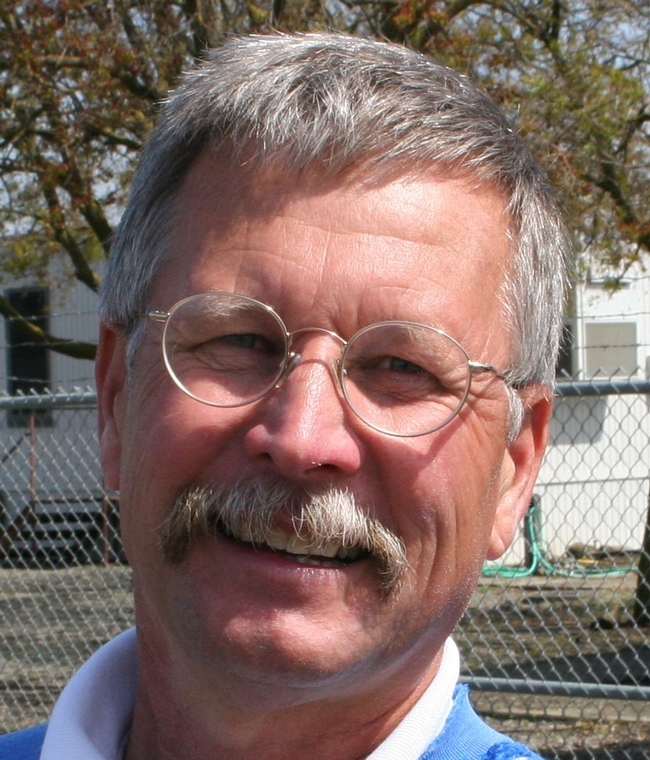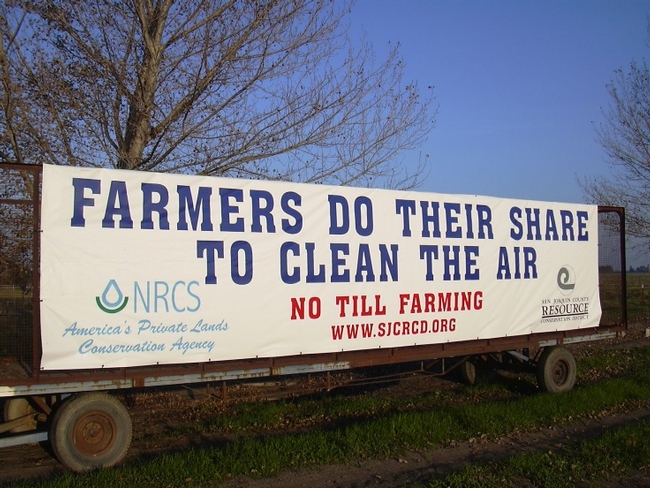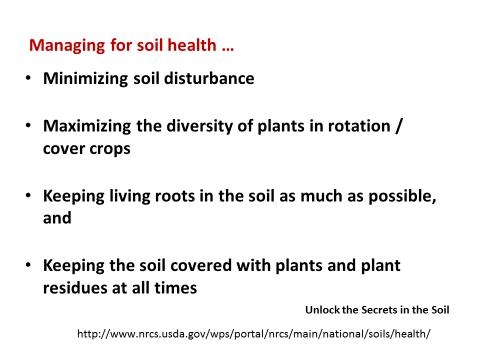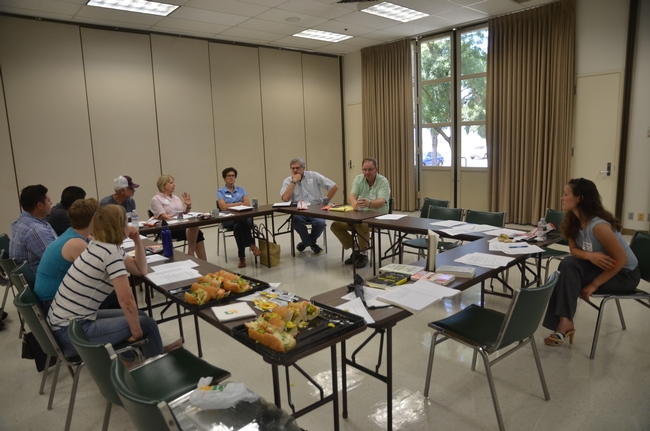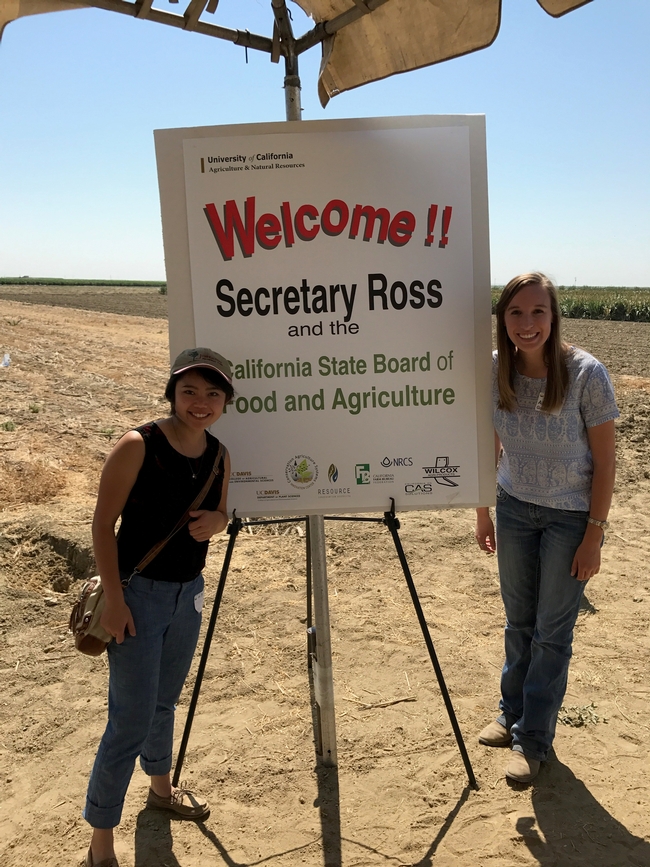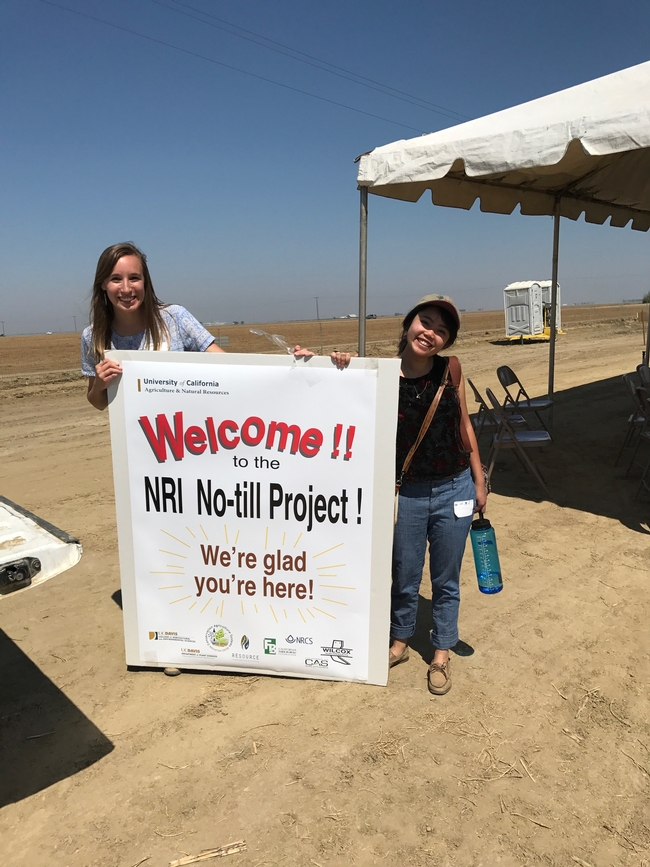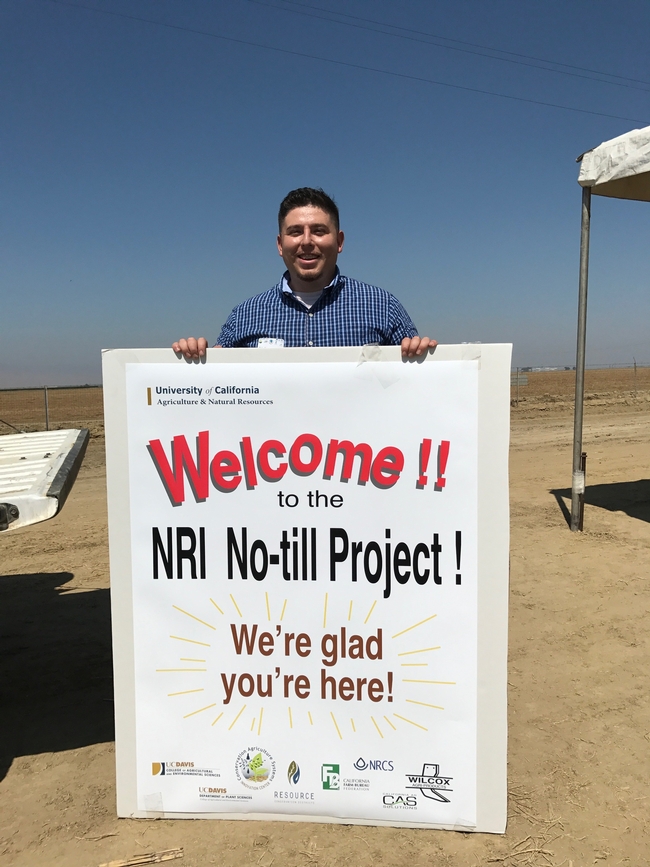Conservation agriculture news
Joint USDA NRCS-CDFA Healthy Soils Summit
Joint USDA NRCS-CDFA Healthy Soils Summit
CDFA Building Auditorium
Sacramento, CA
January 11, 2017
Comments provided by Jeff Mitchell
Late this past Sunday evening, it suddenly dawned on me that I had been dwelling on and dedicating more time and effort to my participation in this afternoon's panel than on my involvement on anything similar to this in maybe 25 years.
This preparation was in part due to the fact that what we are talking about here today IS very important and I am very honored to be a part of it.
I can only hope that what I'm about to share with you now will be worthy of your consideration and thinking.
This has really been a wonderful meeting with lots of great efforts and successes having been shared. The word, “partnership,” for instance, has been mentioned more than 180 times today and this is a good thing.
And at least to this point, there hasn't been any booing or heckling.
Let me begin with a story and a reflection about the poster photo that is there to the left of the main audience.
If you remember driving up I-5 about ten or twelve years ago on the right side of the road just south of Stockton, you could see this large billboard that said, “Farmers do their share to clean the air,” with NRCS and RCD logos on it. It was actually out there for a number of years. The only problem, however, was that there was not a no-till farmer within many, many, many miles of the billboard and there were no no-till farmers within many, many, many miles of that first farmer.
My first point is the question, - Do we run a similar sort of risk with the soil health campaign as is shown in this billboard? Yes, there are some very good things going on, but there are also many rather large opportunities to improve things.
I think we need to avoid or resist the sheer hype that seems to be catching on regarding soil health.
Also, just how are folks going about soil health communication anyway? Exactly what is being communicated?
There is more and more being thought and done about science communication these days, and maybe the soil health campaign might benefit from our putting our heads together within a broader arena or network, and coming up with good plans for outreach.
For instance, how should the actual messaging about soil health be undertaken?
… From a THREAT kind of an angle that conditions are declining and demand attention, or, … from an OPPORTUNITY perspective aimed at benefits of improving soil functions? Just what is being conveyed to the people who are being targeted? These are questions that maybe need further exploration.
My second point has to do with the other poster that is to the main audience's, - right, - the 4 NRCS soil health principles.
If we eliminate the stunningly beautiful vineyard systems of Mendocino County, - that are already approaching, mimicking or emulating of natural ecosystems, and if we further discard the assorted walnut and almond orchards, - where there already is very little disturbance and folks also can add native or cover crop vegetation in inter-crop periods to pretty much achieve implementation of these principles within the constraints that were mentioned earlier in the day, - we are left with largely annual cropping systems or sectors. And while there are some who project that trees and vines will eventually blanket all of the State, I am still somehow hopeful that the tremendous diversity of annual cropping systems will also find a way to persist.
However, there is actually very little sustained, consistent adoption of these principles going on in annual crop systems.
I know of actually only 7 farms in California where this is occurring, - where a consistent, sustained integration and implementation the soil health principles is taking place.
Farmers, as well as sometimes all of us, may think we're actually doing better than we are, as evidenced by a variety of surveys our Workgroup has conducted with farmers about their self-reported adoption of conservation tillage.
- A surprising 53% of them say they're using CT approaches when in reality, the percent if far lower.
- If NRCS wanted to truly have an impact on soil health, they could perhaps close up their office in Ukiah and move it down, say, to Kings, Kern, or Fresno counties.
- Now while that is only a bit of a joke, perhaps the underlying idea, - that some sort of prioritization and tactical planning related to where energy should be best spent to move the overall goal forward would be in order by the prime movers of the NRCS and CDFA soil health initiatives. There are some sectors that are already quite advanced, while there are others less so.
This then, is my third point, - that there is a considerable range with respect to the uptake of soil health practices across the State's farmland and maybe this needs to be thought through a bit more.
And further, in places where progress has been lagging, California is actually way behind efforts and progress in many other places with respect to adoption of conservation agriculture systems and in the use of practices commonly associated with soil health, and in the existence of mechanisms that can help people get there.
- A lot is clearly needed.
- Innovation
- Bolder goal setting
Not just throwing our hands up when facing all the diversity that exists in California with respect to climate, environments, and crops. Those who “play small” and are apologists for the status quo rarely move things forward.
In addition, from some of the advance publicity that was sent out for this summit, and by the way, those responsible for this outreach really did their job. There were recent days when I was receiving seems like 7 or 8 announcements. From this publicity, one might have thought that part of today's summit goals was aimed at identifying management aimed at achieving soil health results.
Folks, - this is well known, well agreed to.
If you reduce the volume of soil disturbed,
If you add organic matter to the soil,
If you keep the soil covered,
If you emphasize soil biology,
...improvements of all sorts will derive with respect to soil function
Actual goals of the soil health campaign
My fourth point has to do with the actual goals of the soil health campaign as currently formulated.
What actual results are being sought?
I have asked for clarification on this from NRCS and there have been unfortunately not much in this regard.
CDFA seems to have a perhaps more cohesive or comprehensive vision in mind that perhaps comes also from their parallel work with emissions reduction and climate-change and water use efficiency-addressed goals, but I would very heartily encourage their pushing very boldly forward with ambitious goal setting.
Let me share two short stories with you to illustrate this point.
The first of these has to do with an effort that is a partnership between farmers, private sector, NRCS, university and other folks from CA, AZ, and NM, - with several of you here today involved, that is looking at designing, testing and refining production system alternatives that are looking “25 years out,” and anticipating goals and techniques that will be needed at that time in the future. This group is focused on vegetable production systems and is actually contemplating no-till lettuce production systems as part of its work.
A second example is a farmer friend of mine in Santa Nella. One day, he and I were sitting in his truck exchanging ideas and information on “CTF,” – controlled traffic farming systems. The idea here is that if you can manage to restrict tractor and implement traffic within a field to certain limited traffic zones, that you could then preserve crop growth zones in between that would be essentially undisturbed. My friend was a tomato farmer and as I was pulling up videos and information on CTF applications from Denmark and other places in the world, he was simultaneously pulling up the very same videos that he himself had found and that provided ideas to him for how to actually begin to achieve controlled traffic systems in his tomato fields. It was nothing short of amazing to see his innovation and “can do” spirit.
What these two examples do is shed light on the tremendous, and maybe to some of you, unexpected willingness to tackle very, very hard challenges and to overcome them. To me, this is utterly inspiring and I would seriously hope that more of this spirit of overcoming obstacles gets somehow into your soil health campaign.
I encourage you in your incentives programs to set a very high bar for the applications that you receive. Encourage true innovation that does not merely incrementally plod forward. Go big and be ambitious with your incentives programs.
“Systems agronomy”
Lastly, and to now wrap up these reflections and suggestions by considering with you a bit more on the goal-setting notion.
If, after all, our collective goal is to increase the adoption of conservation agriculture, soil health, and climate-smart systems, that it is actually more about the “SYSTEMS AGRONOMY” of it all than merely soil health, per se.
Scaling up, or increasing the adoption of conservation agriculture, soil health and climate-smart systems will involve efforts focused on much more than just soil health.
It will involve, - having first of all,- our coming up with a much better set of goals relate to just what results we're actually trying to achieve, - with a very full, comprehensive understanding of the “systems” changes that will be needed.
Borrowing from international circles, and areas where such major changes toward improved performance systems have been made, the term, “SYSTEMS AGRONOMY,” applies here for us, I think.
People who've come to use this term recognize that there are perils in being dogmatic regarding the importance of but one aspect of the entire endeavor. There are parallels, I think, for us here in terms of our need to broaden and not restrict our emphasis and vision.
Made up, first off, of the Greek root terms, “AGRO,” meaning “fields” and “NOMO, - meaning “management.”
How we “manage systems is where we need to be,” not just preoccupied with one aspect of it all, such as soil health.
The second part of the term, “SYSTEMS,” gets more at, - again in the experience of international workers who deal with these sorts of farmer adoption processes and goals, - has to do with the actual communication and innovation mechanics that can best enable or facilitate change toward improved performance systems.
We have much to learn and to do when it comes to the adoption process, and, as already has been mentioned a couple of times earlier today, with the California farm demonstration network that many, many stakeholders are now working to develop and expand, I am quite hopeful that as long as we keep our vision broad and ambitious, and dedicate ourselves to far more creative and challenging endeavors than the sloganeering campaign that has sometimes come with the soil health effort, that we will achieve truly great results.
Thank you very much.
Video report of one-pass no-tillage cotton seeding and cover crop rolling in Five Points, CA 2017
A short video summary on something new this year down in Five Points, - https://youtu.be/dF_BhYv-VtI - our use and application of the DAWN ZRX row unit-mounted cover crop rollers (http://www.dawnbiologic.com/zrx/) ahead of a John Deere 1730 no-tillage planter for circle-planted cotton down here in Five Points.
Things were delayed due to the very late arrival of the DAWNs, but we ended up getting a decent stand of plants and are now going through the remainder of the season to see how things turn out.
As some of you know, these sorts of approaches are far more common in other regions, but as far as I know, this is the first time they've been attempted here in the San Joaquin Valley.
UC ANR Science Communication and Presentation Skills Workshop held at UC KARE August 25th 2017!
A group of UC KARE researchers and UCCE Fresno and Madera County Advisors took part in a two-hour workshop on science communication and presentation skills at the UC KARE on Friday, August 25th. The group included Phoebe Gordon and Rebecca Ozeran of Madera County, Shannon Mueller and George Zhang of Fresno County, Lori Berger, Andreas Westphal, Jeff Dahlberg, Themis Michailides, and Jeff Mitchell of UC KARE, Aldo Garcia of Fresno State, and key meeting presenter, Jessica Chiartas, a PhD soil science student at UC Davis. With introductory information on some of the current thinking and ideas of effective, engaged and connected communication that was provided by Mitchell and Chiartas, the group worked through a number of improvisation and role play exercises aimed at improving the way in which we communicate to the various people and groups that we interact with in our extension education work. In addition, the group solidified a commitment to continue to meet perhaps three or four times annually to form a peer support group aimed at continuing to learn and to explore opportunities for improving our communication skills. Though it was but a small part of the workshop program, participants participated in a pre-workshop video interview about their work and research programs. The video clips from these pre-workshop exercise are archived at the You Tube link https://youtu.be/owhycgHhJ0U Our intent is to go back to folks who participated and conduct a follow-up video interview that might allow everyone to see if and how they've included ideas and techniques that were shared in the workshop into their ongoing work and communication. We look forward to adding folks to strengthen the peer support communication group. If you're interested, let Jeff Mitchell know at jpmitchell@ucdavis.edu or 559-303-9689. We obviously do not have all the answers, but are keen and curious, I think, in learning more and in improving what we do.
Students showcase CASI’s NRI Project in Five Points as part of CDFA’s State Board of Food and Agriculture soil health tour on August 8th!
Students from UC Davis and CSU Fresno presented summaries of work they're involved with at the long-term NRI Project study site in Five Points, CA as part of a soil health tour stop for CDFA's Board of Food and Agriculture on August 8th. Anna Gomes, a UC Davis undergraduate student working with Drs. Daniele Zaccaria and Jeff Mitchell on her senior thesis (along with Stephanie Lew, an Environmental Sciences student also at UCD), and Aldo Garcia, a USDA-NIFA undergraduate research intern working with CSU Fresno professor, Dr. Anil Shrestha, and Jeff Mitchell, had opportunities to briefly share their research work with CDFA State Board members during their visit to the NRI Project field. CDFA Secretary Karen Ross, Deputy Secretary Jenny Lester-Moffitt and CDFA Science Director, Dr. Amrith Gunasekara, were part of the tour group as well as a range of Board members who are appointed by the Governor. UCCE Fresno County Advisor and long-term CASI member, Dan Munk, welcomed the group and led the presentation program at the NRI field that included an introduction to the project's outcomes and findings that was provided by Jeff Mitchell, a discussion of efforts related to reduced disturbance production practices by CASI member and Leopold Conservation Award recipient, Dino Giacomazzi of Hanford, CA, and a summary of an innovative private sector strip-till and precision planting service by Silas and Matt Rossow of California Ag Solutions of Madera, CA. Long-term CASI member and supporter, Eric Kueneman, former Global Director of FAO's Conservation Agriculture programs in Rome, Italy, also took part in discussions with the CDFA visitors. In addition, the group discussed opportunities for scaling up the adoption of improved performance, conservation agriculture, healthy soils and climate smart systems through efforts that are underway with the California Farm Demonstration Network.
New CASI video available
New CASI video available on "Twenty years of no-tilled double-cropped cotton and wheat in Goodyear, AZ" at https://youtu.be/04XJR1tzuGI
For over twenty years, Ron, Robert, and Earl Rayner of Goodyear, AZ have been perfecting a very interesting and successful system of no-tilled double-cropped cotton and wheat at A Tumbling T Ranches in Goodyear, AZ. Their motivations and techniques for this highly innovative system, as well as the many very interesting things that they've learned over the years about how best to implement the practices that they employ are now chronicled in a 41-minute video that is available at the You Tube link above.
The video captures quite a lot of very good innovation and also sheds light on many very important aspects of conservation agriculture including risk management, the overall value of reduced disturbance residue-preserving practices, along with things that the Rayners have learned over the years related to water use efficiency, soil function, and farm sustainability.
Special thanks to Ron Rayner for taking the time to share the many years of dedicated effort in this video.
A shorter, revised version of the video will be available later this year following the 2017 cotton harvest.

